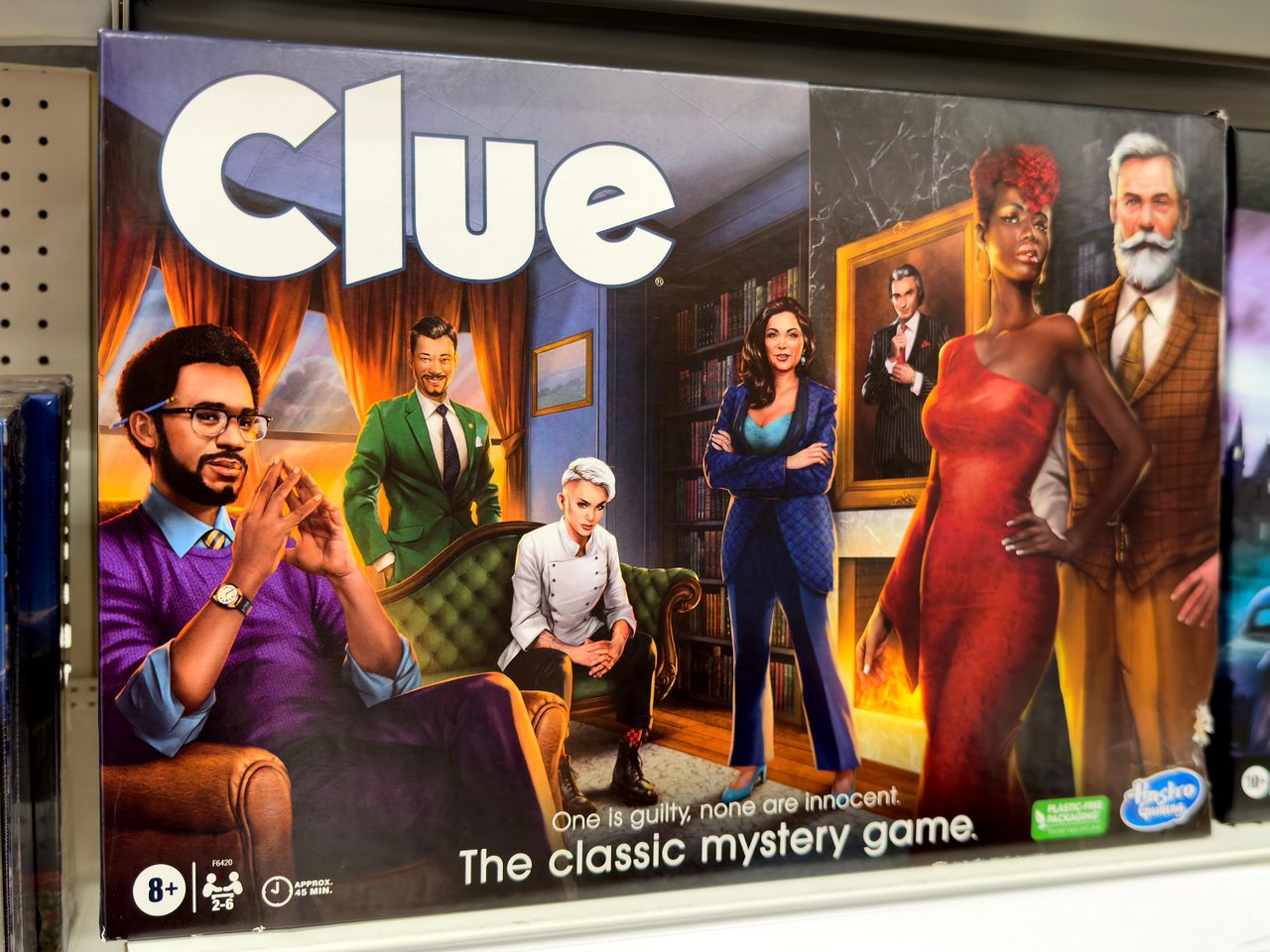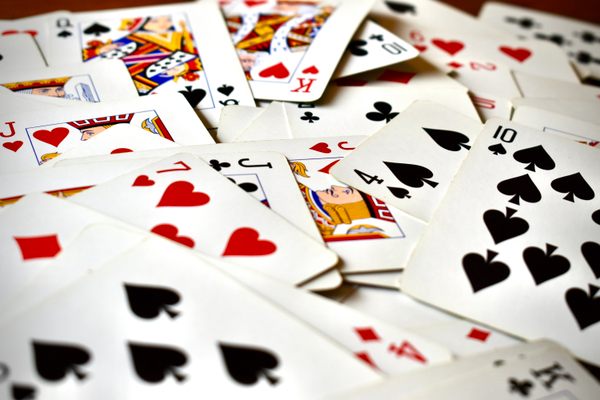From Family Game to Cult Film to ‘Thirst Trap,’ Clue Has Been Through It
The latest glow-up of the iconic board game draws on a wealth of cultural touchstones.

The six suspects are, somehow, more iconic than the crime. There’s the femme fatale, the mutton-chopped military officer, the skittish housekeeper, the sinister businessman, the grande dame, and the absent-minded academic. You might know them better as Miss Scarlet, Colonel Mustard, Mrs. White, Mr. Green (or Reverend Green, a hypocritical Anglican priest, in the British version), Mrs. Peacock, and Professor Plum. They’re together one dark night in an estate called Tudor Mansion when its wealthy owner, Mr. Boddy (Dr. Black in England), turns up dead. You know the rest: rolls of the dice, movement across a room map, probing questions, inductive reasoning: “It was X in the Y with the Z!”
In 2023, the iconic board game Clue got its biggest reimagining since its introduction in 1949. The game mechanics remain essentially unchanged, but the characters look very different. Chef White is young, muscular, and androgynous, with side fade haircut and pronounced cheekbones. Solicitor Peacock wears a curve-accentuating pantsuit, while Mayor Green’s pecs bulge through his close-fitting jacket. Miss Scarlett (who acquired the extra “t” in 2016, matching her British counterpart) and Professor Plum are Black. Colonel Mustard’s facial hair is more hipster Santa than Victorian military. And the victim, Boden “Boddy” Black Jr. aligns the British Dr. Black with the American Mr. Boddy for the first time. The game has big Knives Out energy, with everyone dressed to kill. Clue is now a thirst trap.

Maybe the last time that Clue emerged so seductively from the games closet was in 1985, when it was the basis of a cult classic film version of the board game, which also carried plenty of sexual tension. Clue: The Movie (notorious for its three different endings that confused theatergoers) has earned a place as a touchstone of queer cinema for its camp sensibilities and iconic turns from stars such as Madeleine Kahn, Leslie Ann Warren, and Tim Curry. Now the game has followed suit. LGBTQIA+ publications are swooning over its sexy, gender-bending visual style. “The year is 2023, and every character in Clue is queer now,” wrote Analyssa on Autostraddle, a feminist queer and trans publication. “Every. Single. Character. on this box is hot and gay and ready to ruin your life.” In “The Gays Are Loving Hasbro’s New, Reimagined Clue Characters,” an Out article about the online tizzy surrounding the revamped characters, Andrew J. Stillman noted, of Colonel Mustard, “the official [Twitter] account for Mr. Monopoly even had some thoughts, saying, ‘I guess there’s a new hot grandpa in town.’” As journalist Christian Hoffer tweeted, “I look forward to a generation of kids pointing to the new Chef White as their sexual awakening.”
For Clue’s creator, the game was always an escapist fantasy. Born in 1903, Anthony Pratt was an aspiring pianist from Birmingham, England, who dropped out of school as a teenager to pursue music. He got weekend gigs playing at lavish country mansions, where guests frequently amused themselves by staging elaborate murder mystery games. Eventually, Pratt settled into a life far removed from these estates, and worked at a munitions factory, but he still craved escape and fantasy. Pratt devoured murder novels such as Agatha Christie’s The Body in the Library. “He was fascinated by the criminal mind,” his daughter said in a 2009 interview, adding, “When I was little, he was forever pointing out sites of famous murders to me.” During World War II, as air raids mandated blackouts night after night, Pratt grew bored. So he recreated the glamorous murder parties he’d witnessed in his youth—but in miniature. Elva, Pratt’s wife, designed a game board in the form of a blueprint of a fancy estate, basing it on the cross-and-circle pattern of the British game Ludo, based on the Indian game Pachisi, also called Parcheesi. “Murder!” originally featured 10 color-based characters and nine weapons (ax, bomb, dagger, syringe, poison, poker, revolver, rope, and shillelagh, a knobbed walking stick or cudgel from Ireland) to the modern game’s six and six.

Pratt patented his game in 1947 and sold it to the London toy company Waddingtons. Postwar shortages slowed production, but the game finally appeared on shelves in 1949 as Cluedo, a mashup of Clue and Ludo. Parker Brothers simultaneously released the game in the United States as Clue (since “Ludo” meant nothing to American audiences). In 1953, Pratt sold his share in the foreign rights for a lump sum of £5,000, meaning that through seventy-plus years of editions and spinoffs and reprints—Scooby-Doo Clue, PikaClue, a handsome, 3D luxury edition—Pratt didn’t see a penny. He died in 1994, age 90, in such obscurity that when Waddingtons was planning a celebration for the 150 millionth game unit sold, it set up a Cluedo Hot Line to try to find its creator. (Pratt’s body is peacefully and uneventfully interred in Bromgrove Cemetery in Birmingham.)
Between licensing and reinventions, Clue has undergone nearly as many adaptations and versions as there are possible murder scenario combinations (324). Most recently, in honor of Clue’s 75th anniversary, a Magic: The Gathering edition fuses the murder mystery gameplay with the massively popular collectible card game; to win, you can solve the mystery, or you can just kill your opponents.

One other makeover of the core game took place in England in 2008, with Cluedo Reinvention, which gave Tudor Mansion and the characters a Hollywood treatment. Crime novel expert Kate Summerscale panned the version, noting that even when the game was invented, its “gothic country pile” setting was already a historical fantasy. Imagining a delicious murder in a Hollywood house, she posited, violated the Cluedo vibe. In 2016, Hasbro (the company that subsumed both Waddingtons and Parker Brothers) made a few changes, too: They offed Mrs. White in favor of Dr. Orchid, a PhD in “plant toxicology.” According to the game’s revamped lore, she was the adopted daughter of Boddy, raised by the late housekeeper Mrs. White (gulp), then sent to boarding school in Switzerland—before getting expelled after a mystery “near-fatal daffodil poisoning incident.” Dr. Orchid appeared to be of Asian descent, making her the first character of color to grace the primary cast, and the first female character to have a job outside the domestic sphere, since Scarlet and Peacock didn’t seem to have external sources of income. In some ways, Dr. Orchid represented a return to Pratt’s first version, which included a Nurse White, and had a syringe as one of the potential murder weapons. But Dr. Orchid met a lukewarm reception, with critics calling her a token nod toward gender and racial parity. The switch didn’t take: Chef White’s appearance marks the quiet death of Dr. Orchid. RIP.
For all its changes, the 2023 version is essentially the same moody British country house thing that Clue’s been selling since its origins. But in Clue, backstories and character development are crucial components of the experience, so the new approach does indeed represent something new. It is part marketing gimmick, but there’s something notable about openly embracing its iconic status in the queer community. The makeover doesn’t just bring the board game to a new generation, but breathes new life into the campy stereotypes of the murder mystery genre as a whole. The rebooted characters might not roll off the tongue quite as easily as the old one just yet—Solicitor?—but it crucially allows more people to see themselves in Tudor Mansion. There’s maybe nothing quite so empowering as being able to imagine yourself in a world of lightning, candlesticks, and murder, in any bod(d)y you please.
Adrienne Raphel is the author of Thinking Inside the Box: Adventures with Crosswords and the Puzzling People Who Can’t Live Without Them, a New York Times Book Review Editors’ Choice; What Was It For, winner of the Rescue Press Black Box Poetry Prize; and Our Dark Academia.











Follow us on Twitter to get the latest on the world's hidden wonders.
Like us on Facebook to get the latest on the world's hidden wonders.
Follow us on Twitter Like us on Facebook